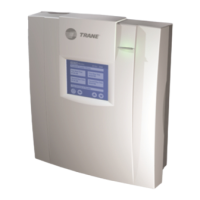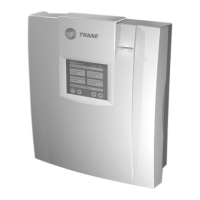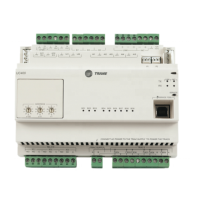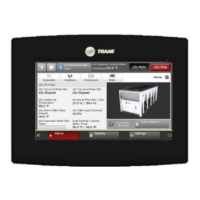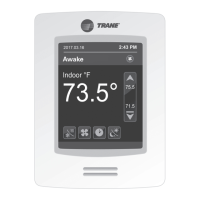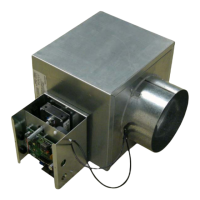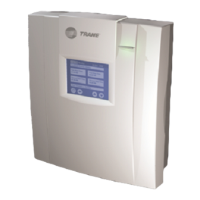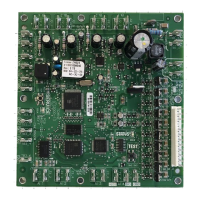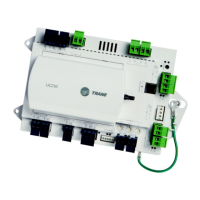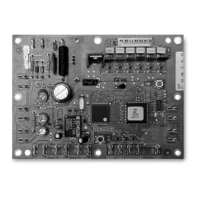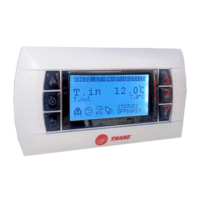CNT-SVX08F-EN 51
Troubleshooting
Binary Output 1 and 2 Troubleshooting
Binary outputs 1 and 2 are TRIAC outputs. They can be used as two separate outputs (staged) or
can control a tri-state modulating actuator. If binary outputs 1 and 2 are always off, then begin with
the troubleshooting steps in Table 23. Perform the steps in the order they are listed.
The troubleshooting steps assume that the outputs ar
e always off, b
ut the troubleshooting steps
are much the same if the outputs are misbehaving in other ways.
Table 23. Binary outputs 1 and 2 troubleshooting of external wiring
Step Number Action Probable Cause
Step 1
Perform the initial troubleshoot
ing steps described in Table 17, p. 47 and verify general board
operation is okay.
General board problem
Step 2
Inspect the wiring. Is there a good connection between the wire and the terminal blocks? Look
for sh
orts or opens. Pay particular attention to wire splices.
Wiring problem
If binary outputs 1 and 2 are still always off, then follow additional troubleshooting steps to assess
the configuration and operation of the outputs. For tri-state modulating outputs, refer to Table 24
and for 2-stag
e outputs, refer to Table 25, p. 52.
Table 24. Binary outputs 1 and 2 troubleshooting of configuration and operation for tri-state modulating actuator
Step Number Action Probable Cause
Step 1
Connect the Rover service tool to the LonTalk communication link, start th
e Rover service tool,
and select the MP501 you are troubleshooting from the Active Group Tree. The device plug-in
for the selected MP501 will appear with the Status screen displayed in the workspace.
Refer to the Rover Se
rvice Software Installation, Operation, and Programming Guide (EMTX-
SVX01).
—
Step 2
Select the Configuration button to display the Device Configuration screen, then select the I/
O tab. Is stag
ed or tri-state modulating selected?
If analog output is selected, binary outputs 1 and 2 are not used.
If staged is selected, go to Table 25, p. 52.
If tri-state modulating is selected, continue with this table.
Output configuration
problem.
Ste
p 3
At the I/O tab of the Device Configuration screen, verify that th
e actuator drive time is not zero.
The outputs will not drive the actuator if the drive time is 0.
Output configuration
problem.
Step 4
At the Device Configuration screen, select the PID tab and ver
ify the maximum output is not
0%. If the minimum and maximum are set to 0%, the output will not change. Verify that the
gains are not 0. If all three gains are 0, the PID output will always be 0%.
PID loop configuration
problem.
Ste
p 5
Select the Close button to display the Status wor
kspace.
Look at the Unit tab. Is the MP501
in unoccupied mode if configured as SCC?
If configured as generic, the MP501 may be disabled. If the
mode is unoccupied (SCC) or
disabled (generic), the controller will drive the outputs to their disabled position, typically 0%.
The disabled position is set on the PID tab of the Device Configuration screen.
If the controller is unoccupied but you think it should be in a diffe
rent state, see “Occupancy
Arbitration (Only SCC Mode),” p. 52.
The MP501 is in
unoccupied
mode (in
SCC applications) or
disabled mode (in
generic applications).
Step 6
At the Unit tab in the Status workspace, check diagnostics.
In SCC mode, if you’re not using the network space temperature input and the hardwired space
temperature input fails
, the tr
i-state modulating output drives to its fail-safe position.
Similarly, in generic mode, if you’re not using the network input and th
e hardwired input
(temperature, flow, pressure, percent, ppm) fails, the tri-state modulating output drives to the
fail-safe position. The fail-safe position is set on the PID tab of the Device Configuration screen.
The controller will return to normal operation when the sensor is no longer failed.
Sensor failure
diagnostic.
Ste
p 7
Compare the input to the setpoint.
In SCC mode the controller may be calculating that no h
eating or
cooling capacity is required
at this time.
Similarly, in generic mode, the input may be near enough to setpoint that the end device should
be driven
closed.
Capacity not required.
Step 8
Check to see if either of the network variables nviCmdOverrid
e or nviEmergOverride is keeping
the end device closed. These variables can override the outputs.
To view nviCmdOverride and nviEmergOverride, refer to the Rover Service So
ftware
Installation, Operation, and Programming Guide (EMTX-SVX01).
Override.
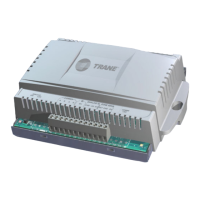
